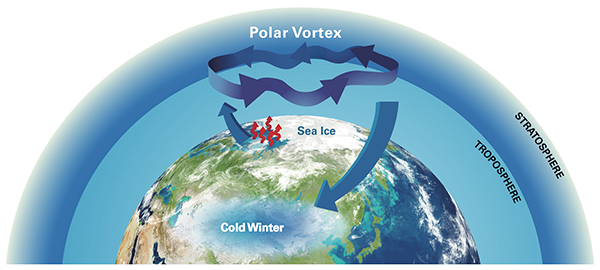Loss of Arctic sea ice impacts cold extreme events
The global climate has been prominently characterized by a warming trend since the late 1970s. However, along with the accelerated warming during the most recent decade, extreme cold winter events and snowstorms have occurred more frequently than earlier decades over the broad areas from Eurasian mid latitudes to the US East Coast. For example, an ice storm swept the eastern US and brought ice condition down to North Carolina and Atlanta in mid February last year, and a “bomb cyclone” occurred in early November this year, causing an earlier, snowy, and cold winter to the lower 48 states. This inconsistency between the global mean surface air temperature and cold weather event occurrence have puzzled and drawn much attention from the climate community, the public, and decision makers. Although various potential mechanisms have been examined or proposed, reasons responsible for the occurrence of these extreme events still remain a highly debated topic.

To understand the increased number of cold extreme events in recent years, a study, conducted by an international team of US and Korean scientists, suggests that the recently drastic reduction of Arctic sea ice cover could be the key driver. By using statistical analysis of atmosphere and sea ice data, and computational climate model experiments, they found that the recent decrease of sea ice (during November – December) in the Barents and Kara Seas causes an enhanced upward propagation of planetary waves, a perturbed pattern of atmospheric flow around the northern hemisphere, which weakens the stratosphere polar vortex. The polar vortex normally circulates over the Arctic stratosphere and holds cold air within the Arctic region during winter. However, the weakened polar vortex has become more variable, and has more frequently shifted southward, bringing cold polar air to lower latitudes. This study provides new information to aid the predictability of extreme cold winter events in a warming climate and has important implications for evaluating future change.
1Korea Polar Research Institute
2Seoul National University
3Pohang University of Science and Technology
4Chonnam National University
5University of Alaska, Fairbanks
6Pacific Northwest National Laboratory
Topics
- Sea Ice
- Arctic
- Extreme Events
